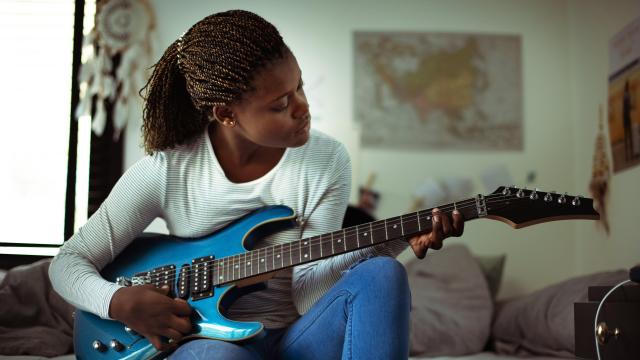There’s never been a better time to teach yourself to play the guitar than now. The number of free (or practically free) guitar resources online is staggering, from gamified learning systems to YouTube gurus to apps that help you keep in time and on tune. But if you’re going to jump in without an instructor, you’re going to make mistakes and have no one to correct them. Below are seven rock-bottom mistakes that just about every “I just started” guitarist makes. Catch them early so they don’t turn into bad habits.
Not playing on time
For beginners, learning basic rhythm is as easy as counting to four or tapping your foot, but it’s probably the most neglected aspect of learning guitar for the self-taught student. No matter what style you’re playing, rhythm is more important than any other element of making music — you could memorise every chord, know how to sweep-pick in Lydian mode, and play a $US10 ($14),000 ($13,882) Gibson, but if you can’t groove, you suck. On the other hand, if you’re rock solid on the beat, all you need to know is one power chord shape and you’re Johnny Ramone. So use a metronome or a beatbox, play along to songs, tap your foot, and count to yourself.
Being too hard on yourself
Learning guitar is extremely difficult. If forces you to contort your fingers into weird shapes, make unnatural movements, and admit to yourself that you sound terrible. It physically hurts until your fingers grow callouses, and it doesn’t start being fun for a while. But don’t get discouraged. This is the same process that every guitarist (except Prince) went through when they started, and there’s no way to skip it. A lot of learning to play guitar is re-wiring your autonomic nervous system through repetition. Once that happens, guitar-feats that once seemed impossible, like switching from an F chord to a C chord in less than a minute, will become automatic responses that require no thought at all. It’s mind-blowing, really.
Not listening to yourself
Lots of beginners, especially self-taught beginners, practice guitar without listening to themselves as they do it. They’re concentrating so hard on where to put their fingers, how to strum, what’s coming next, and everything else, that they’re not hearing the sounds they’re making. You have to consciously listen to yourself as you play. Record yourself and play it back. Play in the dark. Play with headphones. Just find a way to hear yourself.
Along the same line: Try to play by ear. Don’t be intimidated by this, but spend some time listening to music and trying to replicated how it sounds without looking up the tab online. You won’t be able to to do it at first, but you’ll get better.
Not playing with other people
Play with other people as soon as you can play a couple of chords halfway confidently. Even if you suck. Even if you’re nervous. Even if they want to play (shiver) blues. Just do it. Nothing will improve your musicianship more than getting in a group of people and dicking around. Don’t try to impress. Just listen to how it sounds to play with other instruments. Play one note. Who cares? Just make sure the people you’re playing with know your skill level and are cool enough to be like, “Yeah! Plug in!” Instead of “I don’t know. We’re pretty serious.” (Avoid “serious” musicians at all times. Music is for fun.)
Not tuning up
Guitars go out of tune all the time, so before you play, check that your strings sound harmonious. Start by trying to tune by sound alone to work on your ear, but when that gets frustrating, use a tuner. You can get tons of tuners for free for your phone, or pay like $US10 ($14) for a clip-on one. Both options work great.
The video above covers two of my rules. A talented guitarist playing on an out-of-tune instrument illustrates how much tuning matters. But it also shows the importance of playing on time. His de-tuned song sounds wrong and weird, but it doesn’t sound bad exactly. Even playing only random notes will sound weird-but-OK if you play in time (and the rest of your technique is on-point.)
Playing fast before you’re ready
The collective wisdom of all guitarists, ever, is as follows: Learn to play a piece correctly as slowly as you need to, then gradually speed it up. Everyone knows this is the only way it works because everyone has tried to do it differently and everyone has failed.
It’s extremely annoying to play very slowly and makes you feel stupid, but you are never going to master “Thunderstruck” at full speed until you’ve played it at 40 beats-per-minute a half a million times, and then at 45 BPM a half a million times, and so on. To make it easier, check out The Amazing Slow Downer, an app that slows down audio without changing pitch.
Playing “Stairway to Heaven” in a guitar store
“Stairway to Heaven” is a kickass song for a beginner to learn, so you might be tempted to proudly bust it out on a floor model at your local Guitar Centre when you get it down. But if you do, know the consequences. “Stairway” contains one of the “forbidden riffs,” a musical passage your local guitar clerk has heard mangled so many times that they might stop you from playing it or ban you from the store altogether. Other forbidden riffs include “Iron-Man,” “Wonderwall,” and “Smoke on the Water.” This is more of an in-joke than a rule, but you should at least know what you’re getting into before you bust out the Led Zeppelin.

Leave a Reply
You must be logged in to post a comment.